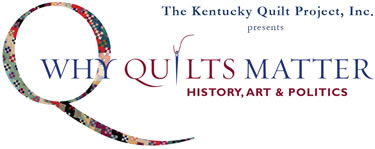The New Vintage – by Bill Volckening
When I first started collecting quilts, anything made before 1900 was an antique and 1930s quilts were vintage. Today, there’s a new vintage, and it’s a trend seen in the last decade with other collectibles. There really wasn’t much interest in quilts from the second half of the 20th century until recently, but the market is quickly heating up. Interestingly, the quilts of this period don’t necessarily adhere to the style commonly known as mid-century modern.

“Wild Thing” Quilt – from Bill Volckening collection
Back in November 2010, I found a flannel-backed, tied spread, crazy block pattern, full of hot colors and wild fabrics from the mid to late 1960s and early 1970s. It was visually exciting, and way outside the box. It was the kind of thing you might find wadded up in a ball under a table at a tag sale, or used to wrap furniture when moving. But I felt it was better than that, much better. Would people laugh at me for thinking it was so great? Did I care?
I call the quilt “Wild Thing” and it kicked off a thrilling period of collecting. Over the last two years I’ve acquired over 100 quilts from the second half of the 20th century, with a strong focus on the 1970s. “Wild Thing” is now on its way to Galway, Ireland, where it will be part of the “Feeling Groovy” exhibit in the International Quilt Festival of Ireland. It was an honor to be invited.
Lately there’s been a lot of discussion among historians about late 20th century quilts. Roderick Kiracofe has collected these quilts over the last decade. In February, he exhibited at QuiltCon, the first national convention of The Modern Quilt Guild. The exhibit was called “Modern Historical Quilts” and included ten of his quilts. He recently released the second of two self-published books, “Quilts 2”, and three of my quilts are in the book.
The current issue of American Quilter Magazine, published by the American Quilters Society (AQS), includes an article I wrote about the quilts of the 1970s. Madge Zeigler of Newark, Delaware, was one of the interviewees in the AQS article. After the magazine came out, she posted a message to her Facebook network about the article and the quilts.
“Keep your eyes open for quilts made from polyester double knits! Prices are rising. This is not an April Fool’s joke,” she said.
Although the quilts are still very affordable, prices have steadily climbed in the last year. A quilt that might have been offered for under $25 back in 2010 may be $50 or even $75 today. More people have started to collect them, and the great quilts are becoming a little harder to find. Many have yet to be offered for sale. Still, it’s uncommon to pay more than $250 for a really good quilt from the period.
These quilts don’t bear a strong resemblance to mid-century modern style, the most prominent design style of the period. They are much more down to earth, and not especially slick looking. Fabrics are cringe worthy to some- primarily polyester double knits and floral cotton calicoes. Patterns tend to be simple and traditional, with much experimental use of color. Bindings are wide, just like men’s neckties of the time, and construction is very basic. Many of the quilts are tied and backed with materials such as flannel or cotton bed sheets. Most of the piecing and appliqué are done by machine.

“Wild Thing” Quilt (Detail) – from Bill Volckening collection
Just like the quilts of other historical periods, quilts of the 1970s usually have a very specific look and feel. They are bold, bright, quirky, and made to be used. Not surprisingly, these quilts inform the work of the Modern quilters- a group that certainly embraces the new vintage. Back in the 1970s, the growing interest in quilts was very much a rediscovery of quiltmaking in America. Today, it’s more like a passing of the torch, and there’s something really great about that.
Bill Volckening
Portland, Oregon
http://www.billvolckening.com
Photography by Bill Volckening



I “rescued” my first almost mid-century quilt top several years ago. It was a top and crumpled up under a box in a thrift stall. The colors are borderline garish and when I tried to quilt it I discovered there was a large “hump” that was not going to quilt out. So I tied it and it lives on my bed.
p.s. Cat not included in original purchase !
http://i25.photobucket.com/albums/c72/honey36_/My%20quilts%20for%20sharing/July2007033.jpg
Love it, and such a sweet kitty!
Lovely quilt (and lounging kitty!), Melissa! Thank you so much for sharing your story with us!